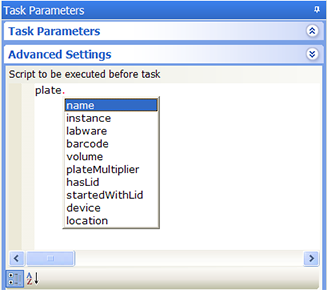plate object
The VWorks JavaScript interpreter provides a plate object that can be accessed by a script. plate provides access to properties of the labware that the current task is operating on. You use the plate object in non-subprocess tasks such as the Place Plate task.
Properties
To see the properties of a plate object:
1 Open a protocol and select a task in the protocol area.
2 In the Advanced Settings area, type plate. The software automatically displays the list of available properties for the plate object.
 |
Instead of displaying the list of plate properties in the Advanced Settings area, you can also list them in the Main Log. Doing so allows you to print the log file and retain a copy of the properties for reference.
To list the plate properties in the Main Log:
1 Open a protocol.
2 Select a task in the Protocol area.
3 In the Task Parameters area, click Advanced Settings.
4 Type the following in the Script to be executed before task area:
for (x in plate) {
print ("plate." + x + " = " + plate[x]);
}
5 Run the protocol. The plate properties appear in the Main Log.
The following table lists the plate properties.
Property | Data type | Description |
|---|---|---|
plate.name | Read-only string | Name of the process. |
plate.instance | Read-only integer | Instance number of the process. |
plate.labware | Read-only string | Name of the labware type. |
plate.barcode | Read-only array | Array of four strings where, SOUTH=0, WEST=1, NORTH=2, EAST=3. The barcode property can be changed by the plate.setBarcode() method. Example: plate.barcode[SOUTH] |
plate.volume | Read-only array of float arrays | An array consisting of one or more arrays of floating-point numbers. The array size depends on the number of wells in the labware (96, 384, or 1536), arranged in row, column format. This property is available only in VWorks software that has the volume-tracking database option. Example: plate.volume[row][column] For 96-well microplates, the maximum row value is 8, and the maximum column value is 12. For 384-well microplates, the maximum row value is 16, the maximum column value is 24. For 1536-well microplates, the maximum row value is 32, the maximum column value is 48. |
plate.plateMultiplier | Read-only integer | The number of microplates needed for the run. This number is based on the number of times the protocol is run and the specifications in the Loop and Change Instance tasks. Examples: • A simple protocol processing Plate_A is run twice. The plateMultiplier is 2. • A protocol loops four times to move contents from the Source Plate to the Destination Plate, and changes instance on the Source Plate only. The protocol is run once. The plateMultiplier is 4 for the Source Plate and 1 for the Destination Plate. |
plate.hasLid | Read-only boolean | The indicator that the microplate currently has a lid. |
plate.startedWithLid | Read-only boolean | The indicator that the microplate entered the system with a lid. |
plate.device | Read-only string | The device that is processing the microplate. |
plate.location | Read-only string | The location on the device where the microplate currently resides. |
Methods
Methods are JavaScript functions invoked through an object. The plate object has the following methods, available on systems that have the volume-tracking database option. Use these methods to track microplate-specific data.
Note: You can use the plate.getUserData() method to retrieve information stored by the plates[n].setUserData() method.
Method | Description |
|---|---|
plate.setUserData(string key, string value) | Stores value under the key in a database record associated with this microplate. The data is retained across runs. The method is only available if the database is installed. |
plate.getUserData(string key) | Returns the ‘value’ stored earlier using plate.setUserData or plates[n].setUserData. (See plates[ ] object.) The method is only available if the database is installed. |
plate.reportErrorToPlugin(string error) | Calls the VWorks Hooks ScriptPlateError method to pass error to the Hooks plugin. |
plate.setBarcode(SIDE, string barcode) | Manually stores the barcode data in plate.barcode[SIDE]. For example: plate.setBarcode(WEST, "A1234") |
Related information
For information about... | See... |
|---|---|
Using JavaScript in the VWorks software | |
VWorks-defined functions | |
Other VWorks-defined objects | |
Using JavaScript utilities | |
JavaScript task | |
Startup and cleanup protocols |